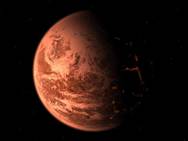“This is the smallest extrasolar planet yet detected and the first of a new class of rocky terrestrial planets,” said team member Paul Butler of the Carnegie Institution of Washington. “It’s like Earth’s bigger cousin.”
Currently around 150 extrasolar planets are known, and the number continues to grow. But most of these far-off worlds are large gas giants like Jupiter. Only recently have astronomers started detecting smaller massed objects
“We keep pushing the limits of what we can detect, and we’re getting closer and closer to finding Earths,” said team member Steven Vogt from the University of California, Santa Cruz.
The discovery of Earth’s distant cousin was announced today at a press conference at the National Science Foundation in Arlington, VA.
The new planet orbits Gliese 876, an M dwarf star 15 light years away in the constellation Aquarius. The “super-Earth” is not alone: there are two other planets – both Jupiter-sized – in the same system. This third world was detected by a tiny extra wobble that it caused in the central star.
From this wobble, the researchers measured a minimum mass for the new planet of 5.9 Earth masses. The planet orbits makes a full orbit in a speedy 1.94 days, implying a distance to the central star of 2 million miles – or about 2 percent of the distance between the Earth and the Sun.
Orbiting so close to its star, scientists speculate that the planet’s temperature is a toasty 400 to 750 degrees Fahrenheit (200 to 400 degrees Celsius). This is likely too hot for the planet to retain much gas, like Jupiter does. Therefore, the planet must be mostly solid.
“The planet’s mass could easily hold onto an atmosphere,” said Gregory Laughlin from UC Santa Cruz. “It would still be considered a rocky planet, probably with an iron core and a silicon mantle. It could even have a dense steamy water layer.”
A paper detailing these results has been submitted to The Astrophysical Journal.
Source: http://www.space.com/scienceastronomy/050613_super_earth.html
* * *
You are welcome to print and circulate all articles published on Clearharmony and their content, but please quote the source.











 more ...
more ...